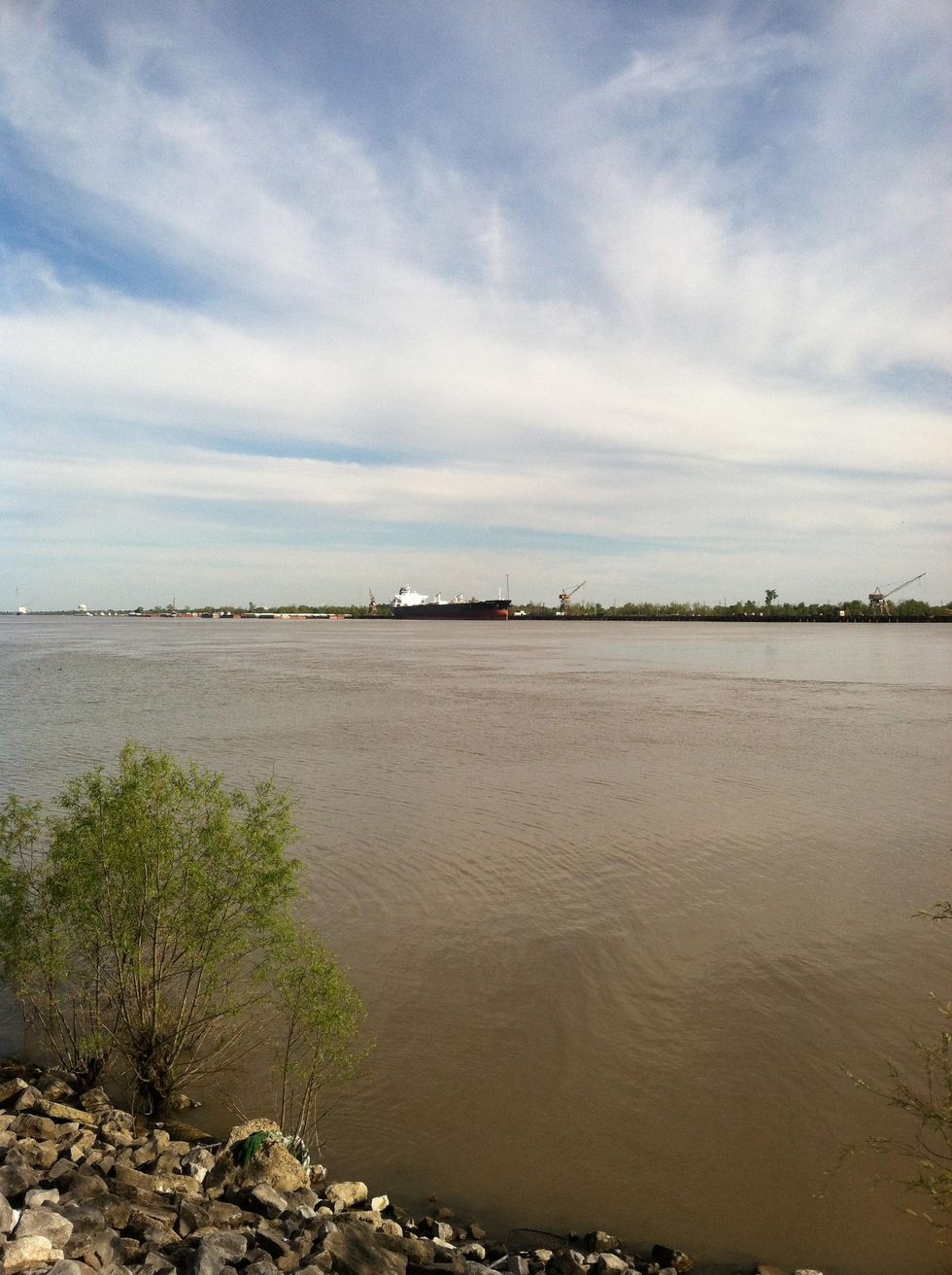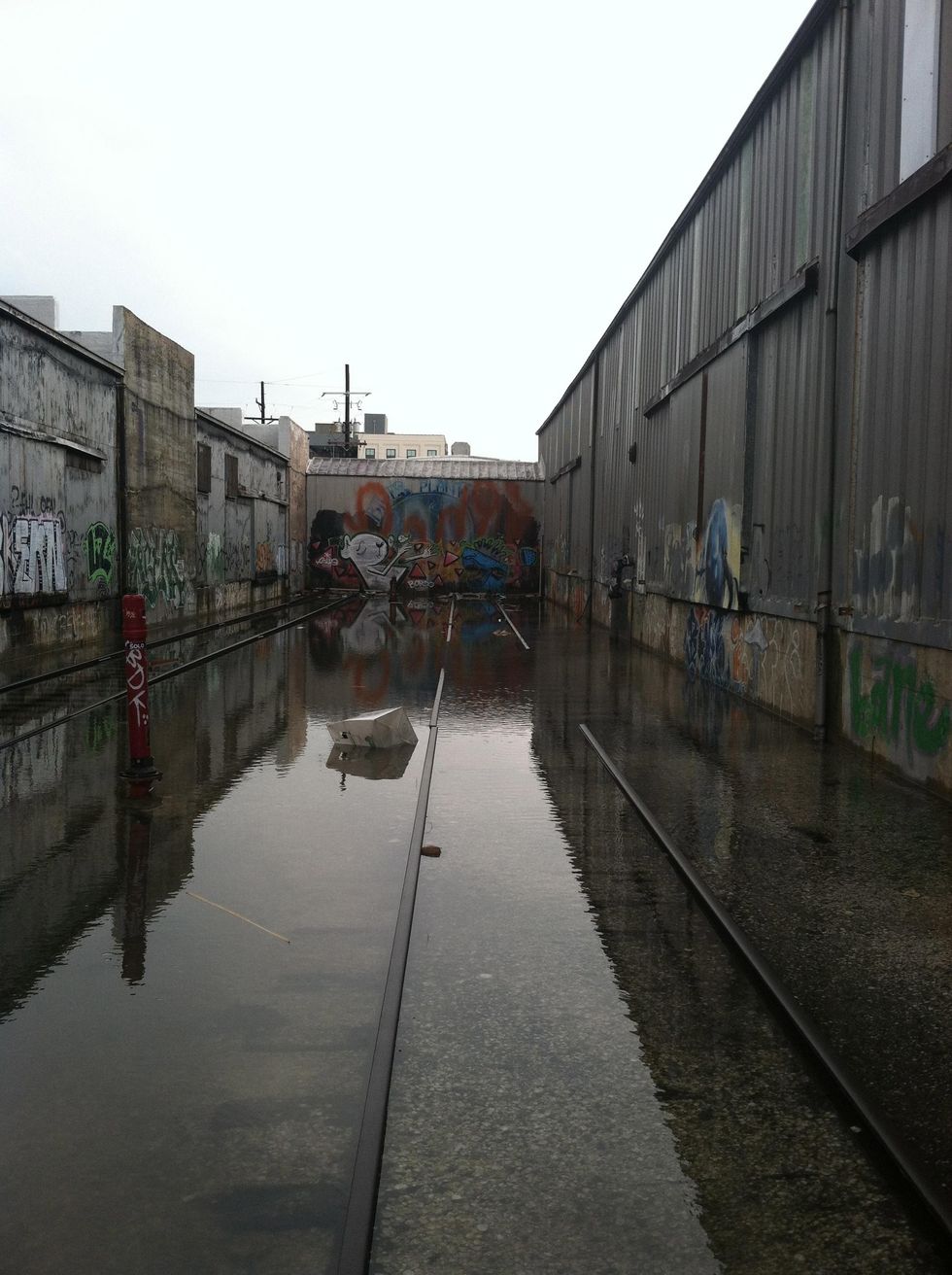Travel & Nightlife
New Orleans's End of the World

By continuing to use our site, you agree to our Private Policy and Terms of Use.

Southeast of the French Quarter, past an already eastern neighborhood called Bywater and across a set of disused railroad tracks, there's a levee locals call The End of the World.
It jets into the Mississippi under the shadow of the East Bank Naval Clinic, a set of three hauntingly desolate buildings decommissioned in 2011, and is bordered by Industrial Canal. A tanker is parked at a dock the city's renting out until it decides how to develop the clinic's 23-acre plot.
There's little public space on the levee, but it's space enough. A narrow sliver of grass determinedly sprouts and cypress trees line the shore, their gnarled roots maneuvering around a rocky riverbed littered with beer bottles and other refuse. A few yards away, under a disused metal radar tower 5 or 6 men and women sit around, looking like they have nowhere else to be and like they're okay with that. A man jogs by with his dog and a group of men and boys, probably fathers and sons, fish a little ways down the 1500 foot levee, closer to civilization.

Across the Industrial Canal stands a solitary red brick building that reminds me of Miss Havisham's decaying mansion in Great Expectations. I later learn it was Holy Cross, an all boys Catholic school. Dr. Craig Troxclair, a New Orleans native son and current Bywater resident, went to school there in the 1980s, just as his father had before, and he has fond memories of his time there. "The main building was three stories and in the summer there was no air conditioner, so they would have all the doors and windows over and you were right on the river so the breeze would just flow through the entire building." Katrina flooded the building beyond repair so the school has since moved, leaving a three-storied shell across from the End of the World. "It will probably be turned into condos," Troxclair says.
Troxclair moved to Bywater in 2004. His house, now a gorgeously renovated Victorian-era home was at that point operating as a crack house, one of many in the neighborhood. It was a far cry from Bywater in which his mother grew up, when she attended Holy Angels, Holy Cross's sister school. That neighborhood, established by French, Caribbean and Spanish settlers during the 19th Century and later home to many Free Born blacks, was first made famous in 1982 1892, when Homer Plessy refused to leave a segregated street car, an incident that led to Plessy v. Ferguson that created "separate but equal." The interwar years saw an increase in white movement into the neighborhood, which wouldn't be called Bywater until the 1940s. That trend reversed in the 1960s and '70s, when residents left for the suburbs and crime and drug use and poverty moved in. Bywater's recent turnaround began around the time Troxclair moved in and accelerated after Bywater emerged as part of the "Sliver by the River," a strip not completely oversaturated by Hurricane Katrina's wrath. You can predict how this urban cycle progresses.

My guide to the End of the World was Kevin Farrell, a writer who aling with his boyfriend, travel writer Nick Vivion, owns a restaurant called Booty's Street Food. Located in the heart of Bywater and opened last November, the space exemplifies the neighborhood's transition. The building was a rundown video store before Farrell and Vivion gave it a major overhaul, including the installation of a patio for their private second level. The plans were controversial at the time -- comments surrounding New Orleans alt-weekly The Gambit's coverage range from praise for Booty's "salvation" of the neighborhood to criticism of "hipster pretense" pushing out natives -- but Booty's has in short order become an anchor in a formerly unmoored neighborhood and, in addition to boasting full dining rooms, the restaurant has expanded its scope by launching Booty's Bywaterloo, an art project in which local artists and celebrities renovate the bathrooms in their vision.
Artist Lauren Marie's contribution featured a skeleton sitting in an unused toilet, mocking the goer and, during my visit, Project Runway contestant Mat Arthur installed a piece titled "Darwin and the Survival of the (out)fittest" that showed early man leaning to walk in heels. Local musician Big Freedia also put together an installation called Beaucoup Booties that featured airbrushed images of big booties and short shorts. "Art is vital to all communities and as a writer and filmmaker myself," Vivion says of the By Waterloo project. "I believe that supporting the arts leads to a thriving, united community."
Some locals, however, remain unconvinced. I overheard a twentysomething man, a recent grad who looked like he was intentionally dressing down, moan to a friend that he wanted to move back to Bywater but that it "sucks" because of the "yuppies." He didn't mention Booty's, but I felt certain he would have if prompted.
Gentrification does have some completely unoffensive perks. When a Section 8 housing project on Clouet Street burned down and the lot was left unattended, Troxclair and his friends began tending the space and then, after seeing its potential, petitioned the city for ownership. The Housing Authority agreed to a 10-year lease at $1 a year. The park is now a favorite for people in and beyond Bywater. On warm nights, they screen movies on an abutting wall. The night I visited, we watched local filmmaker Ashley Brett Chipman's "A Most Complex Form of Ventriloquism," a charming sci-fi short about how good and bad, life and death and up and down are transposed when the moon falls from the sky.
CLICK HERE FOR THE REST OF THIS SERIES, "CHRISTIAN LADIES AND BIKER BOYS."
Want more breaking equality news & trending entertainment stories?
Check out our NEW 24/7 streaming service: the Advocate Channel!
Download the Advocate Channel App for your mobile phone and your favorite streaming device!